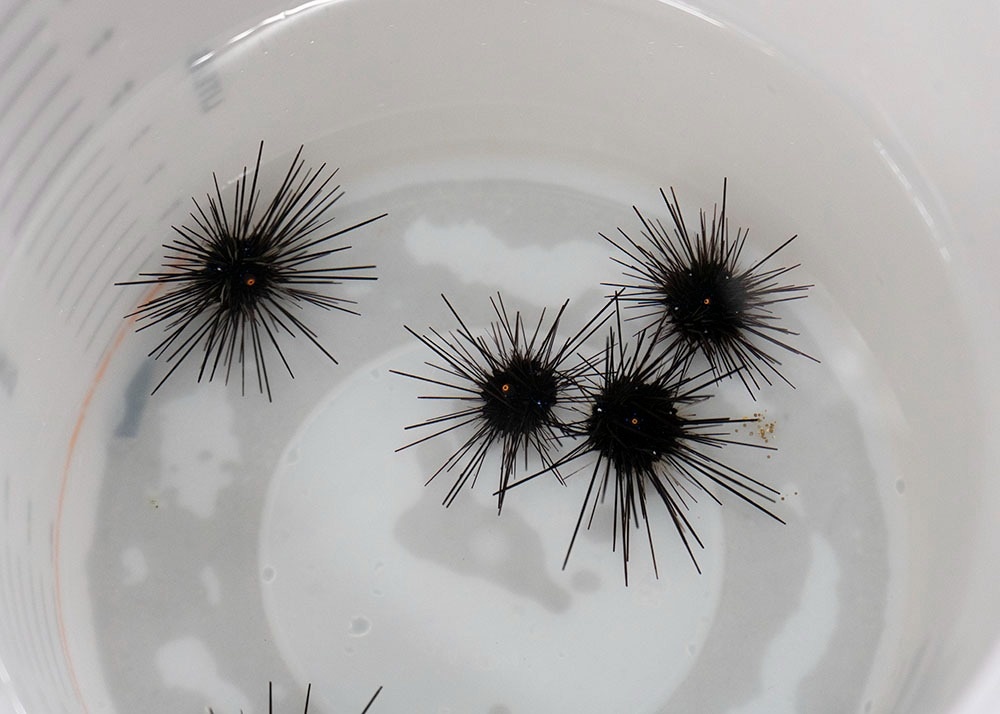A parasite that caused significant devastation to long-spined sea urchins in the Caribbean and Florida in 2022 has now led to another die-off occurring more than 7,000 miles away in the Sea of Oman.
 D. setosum and D. antillarum share the common name of long-spined sea urchin. D. setosum is distinguishable by its orange anal cone as seen here. Image Credit: University of South Florida
D. setosum and D. antillarum share the common name of long-spined sea urchin. D. setosum is distinguishable by its orange anal cone as seen here. Image Credit: University of South Florida
The discovery, which was made by scientists from the University of South Florida College of Marine Science (USF CMS) and was published in The ISME Journal, shows how coral reefs and sea urchin populations are threatened globally by the spread of a microscopic parasite.
Sea urchins play an important role in reef health by eating algae, and when urchins and other herbivores die off, algae can take over and prevent coral from having access to light. A healthy reef tends to have a lot of herbivores.”
Isabella Ritchie, Study First Author and Graduate Student, University of South Florida
Ritchie and her colleagues describe in a recent study that the parasite currently plaguing Diadema setosum in the Sea of Oman is the same single-celled organism known as a ciliate that was found to be the cause of a large mortality event in the urchin species Diadema antillarum last year.
Mya Breitbart said, “We are tracking, almost in real time, the transglobal spread of a devastating marine disease.”
Breitbart is a USF Distinguished University Professor and study co-author. Breitbart and Ritchie also co-authored the 2023 study that identified the ciliate as the cause of the 2022 die-off in the Caribbean.
Approximately a year ago, Breitbart and her colleagues received communication from researchers who noted mass mortalities of D. setosum in the Sea of Oman and expressed interest in collaborating to identify the cause.
Breitbart’s laboratory received infected urchin specimens and conducted genomic tests, confirming the presence of the same ciliate found in the Caribbean within the samples from Oman. Subsequently, they demonstrated that the ciliate caused mortality in D. setosum under controlled conditions.
Not only were we able to determine that the ciliate was present in the samples of D. setosum from Oman, but we were able to purchase live specimens through the aquarium trade and demonstrate that they die when exposed to the ciliate.”
Isabella Ritchie, Study First Author and Graduate Student, University of South Florida
Ritchie was shocked to learn that some of the fish they had ordered via the aquarium trade had the parasite when they got to the lab. Her group made the most of the setback. As in the previous investigation with D. antillarum samples, they cultivated a microbiological culture of the ciliate using samples from the infected D. setosum specimens.
They repeated the experiment with cultures isolated from both species. The outcomes further supported their conclusions.
Reefs from the Mediterranean to Japan are home to a large population of D. setosum, because sea urchins are so abundant, experts worry that the disease may spread to other sea urchin species.
This disease has the potential to spread, and it spread so rapidly in the Caribbean, which suggests it could spread quickly through the Pacific sinc setosum are so widespread. As we know from COVID, the higher a population, the easier it is for a disease like this to spread.”
Isabella Ritchie, Study First Author and Graduate Student, University of South Florida
Questions persist regarding the ciliate's introduction to Oman. Ritchie’s associates are exploring hypotheses, including accidental transportation via international ships, dive equipment, or the aquarium trade. Understanding the ciliate's dissemination could aid in mitigating future die-offs.
Source:
Journal reference:
Ritchie, I. T., et al. (2024) Transglobal spread of an ecologically relevant sea urchin parasite. The ISME Journal. doi.org/10.1093/ismejo/wrae024